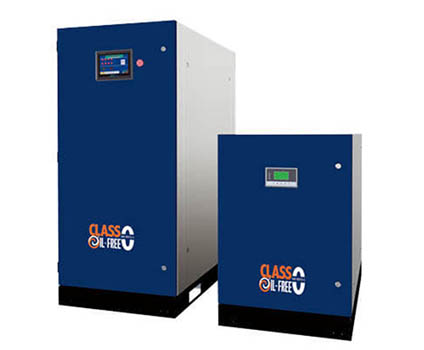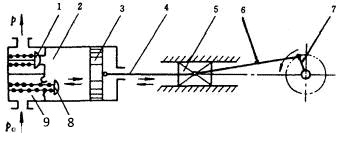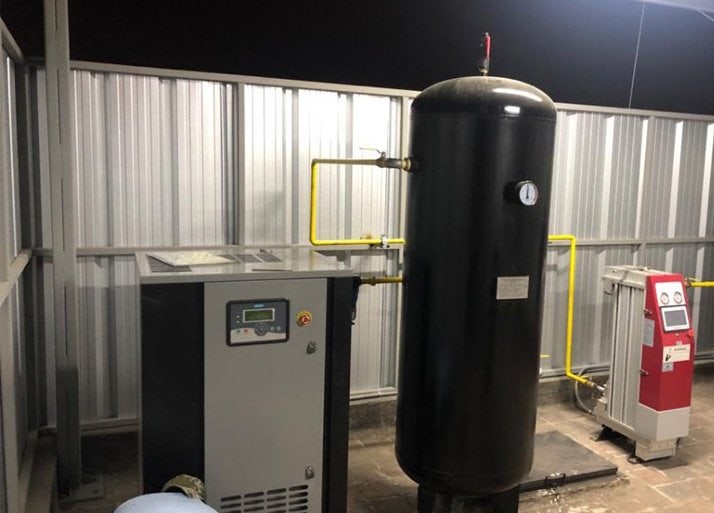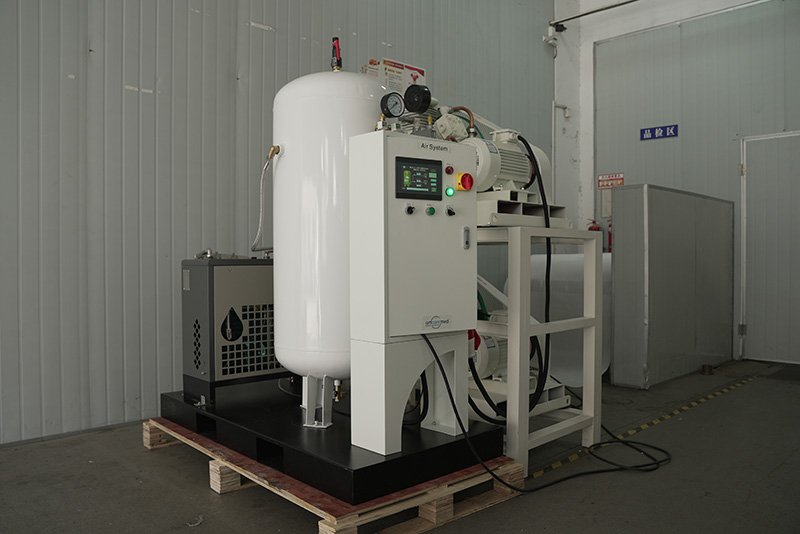Medical air as a direct role in the patient’s important medical gas, medical air supply source must be effectively safeguarded, so the medical air systems should be configured with appropriate equipment to ensure that the quality of the medical air produced meets the relevant regulations. It must be able to supply air continuously and normally in case of failure of a single air compressor or failure of components or parts of any single circuit.
This article will introduce the considerations for selecting medical air compressor devices from 6 parts: medical air compressor, dryer, filter, air quality analyzer, valve accessories, and control system.
1. Medical Air compressor
1.1 Considerations for medical air compressor selection
Medical air compressors should comply with the following regulations:
(1) After-cooler as an independent component should be configured at least two, when the maximum flow of a single after-cooler failure, the rest of the after-cooler should still be able to meet the design flow.
(2) Should be set up a backup compressor, when the maximum flow of a single compressor fails, the rest of the compressor should still be able to meet the design flow. If the total amount of medical air is large, the compressor power will be large according to the principle of one use and one standby. It is recommended that medical and health care institutions should consider the configuration of compressors for more use and one standby, reducing the power of a single compressor. When the volume of gas is small, run only one; when the volume of gas reaches its peak, run two or more, lower operating costs, saving energy.
(3) The same type of medical air compressor should be used, and oil-free air compressors are preferred.
(4) Medical air supply source in a single fault state, should be able to continuously supply air.
(5) Set up a standby air dryer, the standby air dryer should be able to meet the system design flow.
(6) Should be set up to prevent backflow device.
(7) Gas storage tank set should use corrosion-resistant materials or corrosion-resistant treatment.
(8) It is strictly forbidden to transport non-medical air that does not meet medical gas standards into the branch medical gas piping system to ensure the normal operation of medical equipment.
(9) The selected medical air compressors, dryers, filters, pressure-reducing devices, and other equipment should be equipped with backups so that maintenance can be carried out without affecting the use.
(10) Emergency backup power should be provided.
(11) There should be automatic switching function and operating pressure adjustment function.
(12) According to the use of pressure and flow selection of the installation of pressure-reducing devices, each group of pressure-reducing devices can ensure the maximum use of the system requirements.

1.2 Type of medical air compressor
Commonly used in hospitals are mainly oiled (oil-free) piston air compressors, screw compressors, oil-free claw air compressors, and oil-free scroll air compressors.
1.2.1 Piston type air compressor
Piston type reciprocating air compressors are the most common type of volumetric compressor. As shown in the figure below, it is driven by a crank linkage mechanism to change the rotary motion of the piston into the reciprocating motion. The piston and the cylinder together form the working chamber of the compressor, relying on the reciprocating motion of the piston in the cylinder, and with the automatic opening and closing of the inlet and outlet valves, the gas enters the working chamber of the cylinder periodically for expansion, suction, compression, and exhaust.
Piston compressor operation vibration and noise, airflow pulsation is larger, the piston and cylinder wear faster, especially oil-free piston reciprocating air compressor operating cycle is shorter. The medical air delivery systems have less use of piston compressors.

1 – Exhaust valve, 2 – Cylinder, 3 – Piston, 4 – Piston rod, 5 – Slider, 6 – Connecting rod, 7 – Crank, 8 – Suction valve, 9 – Valve spring
1.2.2 Screw type air compressor
Screw type air compressor is to achieve the purpose of compressing gas through the mutual meshing of the two rotors of yin and yang. There are two types of screw compressors: single-screw and twin-screw compressors, and the working principle of twin-screw compressors is shown below.
In the suction end of the rotor, with the engagement of the spiral teeth gradually disengage, between the two teeth to form a volume gradually in the expansion of the cavity, the external gas will continue to inhale, until the pair of spiral teeth engaged again, so as to complete the process of suction. When the interdental cavity runs with the rotor rotation axis to the exhaust end, because the exhaust port is set in a smaller space, the continuous engagement of the two spiral teeth before connecting with the exhaust port gradually reduces the volume of the interdental cavity, so as to achieve the purpose of compressing gas, completing the process of gas compression.
Screw compressor according to the different working medium is divided into oil-free screw compressor, micro oil screw compressor. Water screw compressor is also a type of oil-free screw compressor.
1.2.3 Claw type air compressor
Claw type air compressor compression process with the rotation of the rotor air from the intake port into the casing was sealed in two rotors and the casing wall to form a sealed cavity; as the sealed cavity is reduced, the gas is continuously compressed, and finally discharged through the exhaust port compressed gas, as shown in the figure below.

1.2.4 Scroll air compressor
Oil free scroll compressors include a pair of static scroll discs fixed inside the shell and motor-driven eccentric track of the dynamic scroll discs, the two scroll discs are installed into a 180 ° phase difference in order to form a cavity with a gradual change in volume, as shown in the figure below.
Once the air is drawn in, the air is gradually compressed and discharged from the exhaust hole in the center of the static vortex disk as the moving vortex disk moves in a circular motion in the plane driven by the spindle. This process is repeated continuously so that the discharged compressed air is continuous without fluctuation.

1.3 Comparison of several air compressors
Air compressors have different characteristics due to their working principle, structure, exhaust pressure, transmission mode, rotation speed and use range, etc. Several common air compressor characteristics are compared as follows.
| Category | Oil-free air compressor series | Oil lubricated air compressor series | |||
| Name | Oil-free screw | Oil-free Scroll | Oil-free Claw | Micro oil screw | Micro oil piston |
| Working Principle | Volumetric | Volumetric | Volumetric | Volumetric | Volumetric |
| Hospital use | Often | Often | Often | Often | Rarely |
| Air quality | Oil-free | Oil-free | Oil-free | With oil | With oil |
| Size | Middle-large | Small/medium | Small/medium | Small/medium/large | Small/medium/large |
| Noise | Medium | Low | Medium | Medium | High |
| Operating condition | Continuous | Intermittent | Continuous | Continuous | Intermittent |
| Reliability | Good | Average | Very good | Average | Average |
| Transmission method | Direct link gear | Drive belt | Direct link gear | Direct link gear/Drive belt | Drive belt |
| Application industry | Medical, pharmaceutical, electronic, food | Medical, pharmaceutical, food | Medical, pharmaceutical, electronic, food | Medical, air separation, instrumentation, automation | Medical, air separation, instrumentation, automation |
| Vibration | Small | Small | Small | Small | Large |
| Maintenance rate | Less, regular maintenance | Less, regular maintenance | Less, regular maintenance | More, regular maintenance | More, poor stability |
2. Dryer
The dryer shall comply with the following provisions.
(1) The dryer should have a backup machine, the backup air dryer should be able to meet the system design flow.
(2) It is appropriate to use adsorption dryer.
(3) The dryer should be used more than 20% ~ 30% of the air output of the compressor set, and the pressure should be 1.0MPa.

3. Filter
The filter should comply with the following provisions.
(1) The filter should be installed on the inlet side of the pressure-reducing device.
(2) Not less than two levels of air filters should be set up, and each level of filter should be set up as a backup. The filtration accuracy of the system should not be less than 1μm, and the filtration efficiency should be greater than 99.9%. It is appropriate to use 3 or more 3 levels of filter configuration.
(3) When the compressor is not a full oil-free compressor, an activated carbon filter should be set.
(4) Bacteria filter can be set at the last stage of the filtration system, and should comply with:
- The filtration precision is 0.01 ~ 0.2μm, and the efficiency should reach 99.955%.
- A standby bacterial filter shall be set up and each group of bacterial overderers shall be able to meet the design flow requirements.
- Medical gas bacteria filter treatment shall take measures to monitor the performance of the filter element.
(5) Filter cartridge performance monitoring measures should be set up at the filter.

4. Air quality analyzer
Medical air supply source should be set up the pressure, moisture, carbon monoxide impurity content real-time online detection facilities, detection analyzer the maximum measurement error of ± 0.1%.
5. Equipment, piping, valves, and accessories
The setting and connection of equipment, piping, valves, and accessories shall comply with the following provisions.
(1) compressor, after-cooler, gas storage tank, dryer, filter, and other equipment should be set between the valve. Gas storage tank should be used for equipment or install a bypass tube.
(2) compressor inlet and exhaust pipe connection should be flexible connection.
(3) The condensate discharge of the gas storage tank and other equipment should be set up automatically and manually drain valve.
(4) The pressure reducing device should contain a safety valve of two-way type, each way should be able to meet the maximum flow safety relief needs.
(5) gas source outlet should be set up gas sampling port.
6. Control, monitoring, and alarm system
Control, monitoring, and alarm system should comply with the following provisions.
(1) Each compressor should be set up with an independent power switch and control circuit.
(2) Each compressor should be able to automatically put into operation one by one, and the compressor should be able to start automatically after the power failure is restored.
(3) Automatic switching control should make each compressor evenly distribute the running time.
(4) The control panel should display the running status of each compressor, and there should be an indication of the running time of each compressor in the unit.
(5) The requirements of monitoring and alarm shall conform to the provisions of relevant medical gas engineering technical specifications.
(6 ) There shall be a fault sound and light alarm device with a red alarm indicator, and it is required that under 55dB( A ) noise environment, the sound alarm shall be heard and the red indicator alarm shall be seen within 1.5m.

To learn more about medical gases, please check other articles or feel free to contact us.
